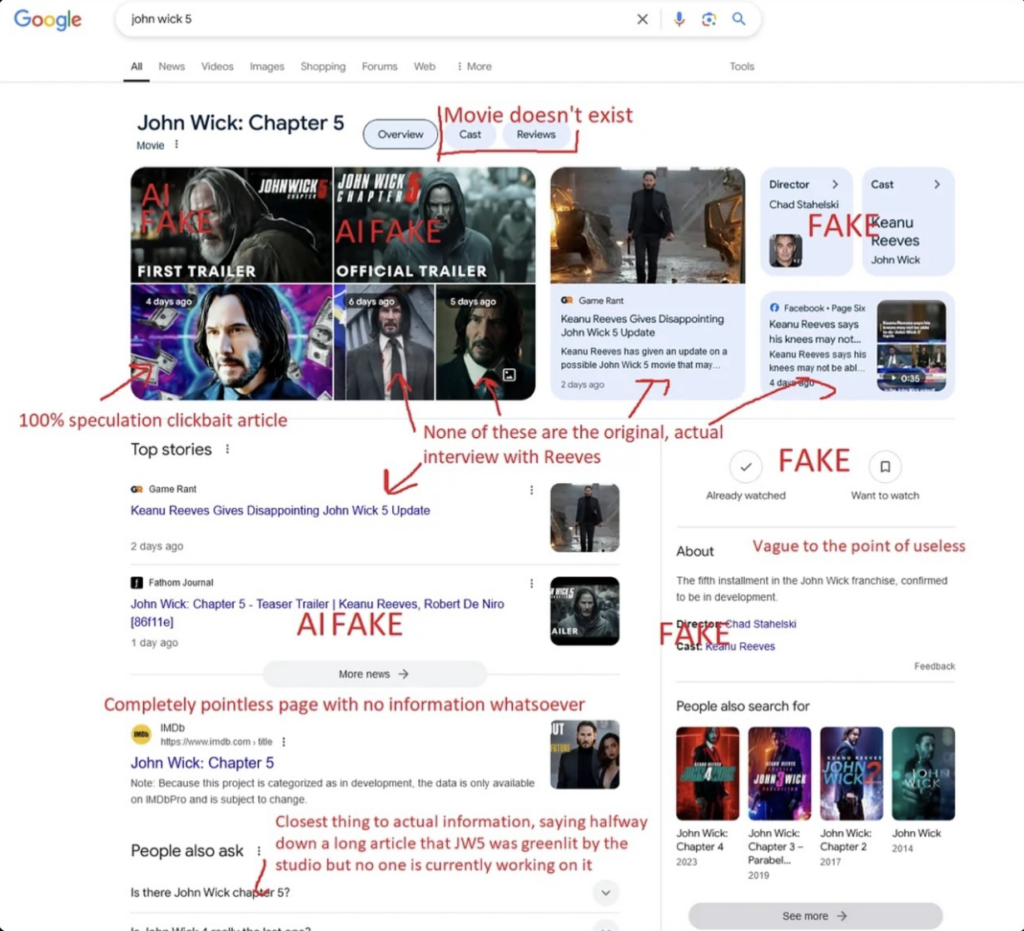🪦 Is 2025 the year of the “Dead Internet”?
The line between human and machine is blurring. Is the internet becoming a sea of bots—or is there still room for real connections?
Key Facts
- 🤖 Nearly half of internet traffic is automated: Back in 2023, about 49.6% of online activity already came from bots and automated systems
- 📈 AI-generated content is on the rise: Social media platforms are seeing an influx of AI-created posts and images.
- 💬 Authentic human interaction is at risk: The surge in automation could drown out genuine human voices online.
Ah, the Dead Internet Theory.
What started out as a fun conspiracy theory has turned into an increasingly real concern about the state of online content and interactions.
Take a look at this example below. See anything that looks both common and concerning?

Yep, just about everything possible in that one example has no value.
We’re not even talking about “AI isn’t doing as good of a job writing as a human would”, we’re highlighting a problem with wrong information flooding our internet.
Let’s break it down…
Since around 2016, a significant portion of the internet has allegedly been overtaken by bots, AI-generated content, and automated interactions.
In 2023, nearly half of all internet traffic was automated—and it’s not slowing down.
Social platforms like Meta were even planning to roll out AI-powered accounts that can generate their own content and then were met with IMMENSE criticism when everyone caught on.
By 2026, experts predict bots could dominate up to 90% of online traffic.
What’s behind this shift?
The rise of AI has made generating content easier than ever.
I mean, I use it. And I want you to as well.
Tools like ChatGPT and image generators create text, images, and videos that are nearly indistinguishable from human-made content.
Search engines and social platforms prioritize automated, SEO-optimized material, sometimes burying authentic voices.
And companies and individual users alike benefit from AI’s efficiency, using it to scrape data, generate clicks, and even mimic human interactions.
I’m a huge advocate for using AI to make our lives more efficient, creative, and easy.
But that’s not to say I don’t see the downsides of what could become of a completely automated internet.
So, what are the REAL consequences…not just “conspiracies.”
- Information Overload: As bots flood the internet, finding genuine, trustworthy content becomes a challenge.
- Loss of Authenticity: AI can simulate emotions and insights, but it can’t replicate the depth of real human experiences.
- Eroding Trust: As more of our interactions feel artificial, it’s harder to tell what’s real and who’s behind the screen where it’s not made clear from the start.
We need to combine human connection with the benefits of AI.
Here are some thoughts:
- Lead with Humanity: Share personal stories, emotions, and experiences. Bots can’t replicate the nuance of lived moments.
- Engage Directly: Build meaningful connections in spaces like email newsletters (like this one!) or smaller community platforms where human interaction thrives.
- Stay Curious: Learn how AI shapes the internet, so we can better navigate it and make intentional choices about our online presence.
- Set Standards: Use AI responsibly—let it support our creativity, not replace it. Transparency builds trust.
- Be Honest: Tell others that AI is behind the work you do and you’re proud of it. You’re not there to fake or or take them for a ride, but use these tools to better serve them.
The internet is changing rapidly, but we don’t have to lose what makes it special..
Real connections between real people.
For example, for the past month I’ve been doing some serious content automation work behind the scenes and building something I’m really proud of.
It’s a way of me experimenting, learning myself, and testing channels with the strategies I’ve learned over the years. Early signs show it’s going to work great and I’m excited to share it with you all in February.
I call it Project AISEO Moat. And I’ll be releasing parts of it to my Bara AI 🔗 customers for their podcasts and channels in Q1 too.
AI runs this show, but the focuses and direction is inspired by me – someone who’s spent over a decade in SEO & content marketing. And I’m leaning into the fact AI plays a big part.
So what are your thoughts on Dead Internet Theory; I’d love to hear?
⚡ The New Minimax Is Affordable, Accessible, and a Step Ahead of the Competition.
An AI capable of processing entire books, research papers, and massive codebases in one go. This open-source model isn’t just about capacity.
Key Facts
- 📝 Massive context window: MiniMax-01 supports up to 4 million tokens, doubling the capacity of leading models.
- 💰 Cost-effective solution: It’s 10 times cheaper than similar models, costing $0.20 per million input tokens.
- 📚 Can process multiple books at once: Analyzes several novels in a single go.
Hold on to something.
Meet MiniMax-01, an open-source AI model that supports a context window of up to 4 million tokens.
To put that into perspective, Tolstoy’s War and Peace is about 570,000 tokens.
The complete Lord of the Rings trilogy: ~650,000 tokens.
The entire Harry Potter series: ~1.2 million tokens
This means MiniMax-01’s context window could theoretically process:
– 7 complete copies of War and Peace
– 6 complete Lord of the Rings trilogies
– 3 complete Harry Potter series with room to spare
Not sure why it’s even called Mini-anything at this point.
Just a few years ago we were going crazy over 128k and now we’ve hit the point where 4 million can be the new norm.
Use cases for working with this much data:
Data Analysis: Process entire codebases or extensive documents without losing context. Imagine debugging or refactoring with a comprehensive view!
Research: Analyze complex research papers along with all their references. This could change how we approach academic studies.
Literature Exploration: Really get into entire book series, comparing themes and character developments across volumes.
And the best part?
It’s affordable. At $0.20 per million input tokens, it’s accessible even for indie developers and small businesses.
I’m already thinking how to integrate this project ideas I’ve had where token count was a limiter until now.
Feel free to check it out at hailuo.ai 🔗 If you decide to give it a whirl, I’d love to hear about your experiences and any creative uses you find!
💵 U.S. AI Startups Raise Record $97B in 2024
AI startups made a significant shift in venture capital priorities, highlighting a growing confidence in AI’s transformative potential.
Key Facts
- 📈 Massive Investment Rounds: 2024 was defined by “megarounds” that saw billions poured into leading AI companies.
- 🌍 Global Comparison: Europe and Asia followed with $61.6 billion and $75.9 billion in startup funding, respectively.
- 💡 Shifting Venture Capital Priorities: AI-focused startups accounted for nearly half of all U.S. startup funding in 2024, highlighting the growing dominance of AI in venture capital investment strategies.
AI was the jump-start we needed for the tech world.
Here’s a brief history over the past fivish-years:
Pre-Pandemic Period (2018-2019)
– Silicon Valley dominated with nearly 50% of all U.S. venture funding in 2018
– Tech startups showed the highest business failure rate at 63%
– Traditional venture funding patterns were stable with predictable growth
Pandemic Impact & Peak (2020-2021)
– 2021 marked a record year with $621 billion in total tech startup funding
– U.S. startups captured half of global funding at $311 billion
– Valuations reached historic highs across all stages
The Decline (2022-2023)
– VC funding began dropping in Q1 2022, falling 13% from Q4 2021
– 2022 saw a 35% overall decline from the previous year
– 2023 hit the lowest venture funding levels since 2018
– Approximately 3,200 private venture-backed U.S. tech companies failed in 2023
The AI-Led Recovery (2024)
– Overall funding grew from $74.9B to $84.3B, primarily driven by AI investments
– AI startups captured 22% of priced rounds, up from just 5% in 2020
– Silicon Valley’s share of U.S. venture funding decreased to 35%
– Early-stage funding showed steep declines while late-stage deals saw the largest gains
– Non-AI startups continued to struggle with fundraising and valuations
All in, 2024 was defined by “megarounds” that saw billions poured into leading AI companies:
- Databricks: $10 billion
- OpenAI: $6.6 billion
- xAI (May and November): $6 billion each
- Waymo: $5.6 billion
- Anthropic: $4 billion
These numbers underscore immense investor confidence.
Elon Musk’s xAI alone raised an astonishing $12 billion across two rounds, showing the fierce competition to back AI leaders.
The U.S. continues to dominate in both funding and innovation, attracting more capital than entire startup ecosystems in other regions.
Not to mention… Global AI investment is projected to reach $200 billion by 2025, with U.S. companies leading the charge at approximately $100 billion.
But the focus is shifting:
- Investors are scrutinizing startups to demonstrate tangible returns.
- Real-world implementation is taking center stage, moving beyond the hype.
2025 will be a year of practical application.
Companies are scaling AI operations, with 46% of executives planning to expand usage and 44% focusing on innovation.
A couple predictions…
- Productivity Gains: AI is expected to drive 10% revenue increases per employee, demonstrating its potential to enhance workforce efficiency.
- Broader Market Impact: AI benefits may extend beyond tech giants in 2025, creating opportunities for smaller companies to make their mark.
But.. only for those companies willing to use these.
It’s no longer a question of if, but when – and I’m over here screaming from the rooftops “when is yesterday”.
If you’re not using some AI-tech now…
…what are you holding out for?
I run an incredible private community for leaders like you who are interested in AI development and implementing it into their own personal and professional lives.
Right now, it’s open for enrollment.
- 🤝 Networking & Collaborations
- 🧠 AI Insights & Tools Showcase
- 📆 Monthly Q&A “Office Hours” with me
- 📞 A 1:1 Welcome Call for us
- …and more!
Check it out here: https://fastfoundations.com/slack 🔗
